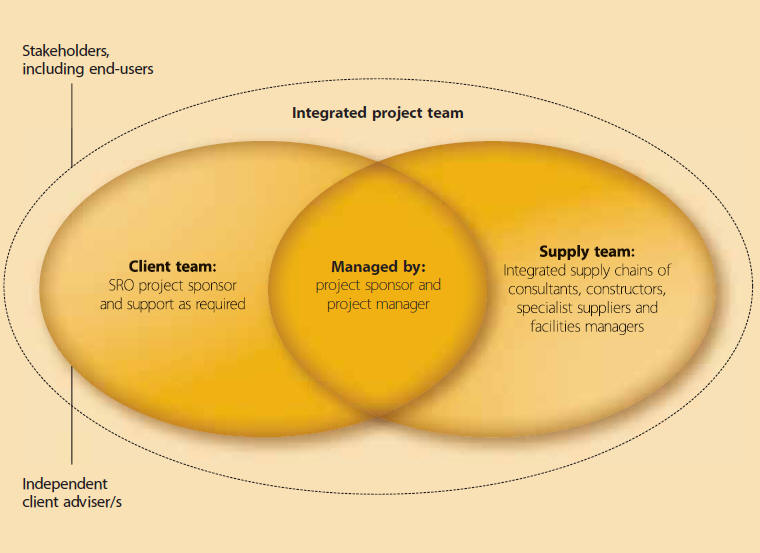Integrated supply team
'Integrated supply team' is a term used to describe the integration of the complete supply chain involved in the delivery of a project. This may include the main contractor, designers, sub-contractors, suppliers, facilities managers, and so on.
The integrated supply team differs from the term 'integrated project team' as it relates only to the main contractor and their supply chain (designers, sub contractors, suppliers, etc.), whereas the integrated project team includes the client, and a project manager if there is one.
The relationship between the Integrated project team and the supply team is illustrated in OGC guidance as shown below:
[Image ref AE5:The integrated project team: teamworking and partnering P5.]
The integrated supply team is particularly relevant on public projects as the recommended procurement routes proposed by the government are private finance initiative (PFI), prime contracting and design and build with very early appointment of the integrated supply team. Under these routes, the entire supply team (designers, contractors, specialist suppliers and facilities managers) are appointed after the project brief has been prepared, and may involve just one single contract with the entire integrated supply team, not separate contracts with individual companies that make up the supply chain.
This is a model that is increasingly being adopted in the private sector, as clients seek a single point of responsibility for delivery of a project, and also because of the increasing need to involved specialist suppliers and contractors in the design process. The Strategic Forum Integration Toolkit suggests that contracting with a single supply team rather than separate companies is possible for small and occasional clients as well as larger more experienced clients.
NB: The Office of Government Commerce (OGC) has now been absorbed into the Efficiency and Reform Group (ERG) within the Cabinet Office. OGC guidance has been archived, however, it is cited in the Government Construction Strategy and the Common Minimum Standards.
[edit] Related articles on Designing Buildings
- Adversarial behaviour in the UK construction industry.
- Design and build.
- Collaborative practices.
- Consultancy.
- Consultant team.
- Corporate objectives for procurement.
- Designers.
- Government Construction Strategy.
- Green supply chain management.
- Integrated project delivery (IPD).
- Integrated project insurance.
- Integrated project team.
- Major Projects Authority.
- OGC.
- Prime contract.
- Private finance initiative.
- Public procurement.
- Supplier assessment.
- Supplier selection.
- Supply.
- Supply chain.
- Supply chain management.
[edit] External references
Featured articles and news
One of the most impressive Victorian architects. Book review.
RTPI leader to become new CIOB Chief Executive Officer
Dr Victoria Hills MRTPI, FICE to take over after Caroline Gumble’s departure.
Social and affordable housing, a long term plan for delivery
The “Delivering a Decade of Renewal for Social and Affordable Housing” strategy sets out future path.
A change to adoptive architecture
Effects of global weather warming on architectural detailing, material choice and human interaction.
The proposed publicly owned and backed subsidiary of Homes England, to facilitate new homes.
How big is the problem and what can we do to mitigate the effects?
Overheating guidance and tools for building designers
A number of cool guides to help with the heat.
The UK's Modern Industrial Strategy: A 10 year plan
Previous consultation criticism, current key elements and general support with some persisting reservations.
Building Safety Regulator reforms
New roles, new staff and a new fast track service pave the way for a single construction regulator.
Architectural Technologist CPDs and Communications
CIAT CPD… and how you can do it!
Cooling centres and cool spaces
Managing extreme heat in cities by directing the public to places for heat stress relief and water sources.
Winter gardens: A brief history and warm variations
Extending the season with glass in different forms and terms.
Restoring Great Yarmouth's Winter Gardens
Transforming one of the least sustainable constructions imaginable.
Construction Skills Mission Board launch sector drive
Newly formed government and industry collaboration set strategy for recruiting an additional 100,000 construction workers a year.
New Architects Code comes into effect in September 2025
ARB Architects Code of Conduct and Practice available with ongoing consultation regarding guidance.
Welsh Skills Body (Medr) launches ambitious plan
The new skills body brings together funding and regulation of tertiary education and research for the devolved nation.
Paul Gandy FCIOB announced as next CIOB President
Former Tilbury Douglas CEO takes helm.























